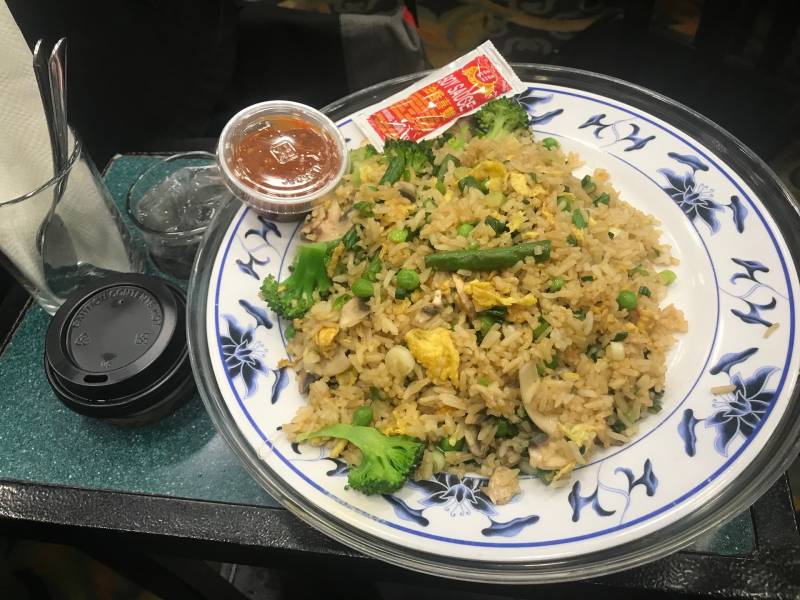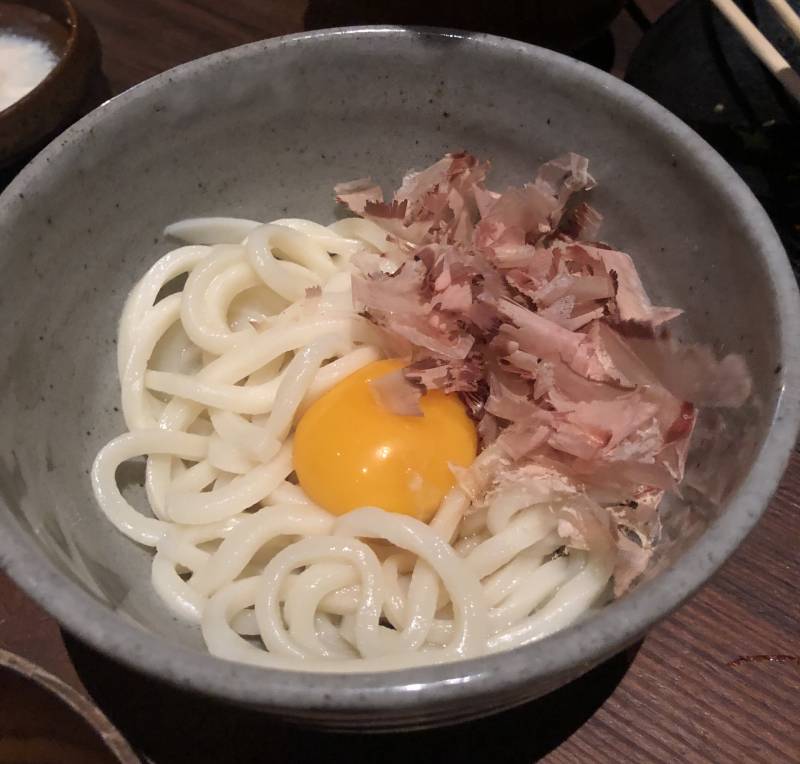Dining in the Bay Area can mean lots of optimized salad bars and grain bowls inhaled between meetings. Here, KQED staffers share recent meals that demanded we slow down and enjoy them thoroughly.
Rintaro's Delicate Udon Carbonara
Cracking open the yolk of a semi-cooked egg has become a cheap trick on the internet. Videos of gooey yolk spilling onto bread, rice, or even a bare plate continue to drive people into a frenzy with heart-eyed emojis abound. Though I love eggs, I don't necessarily fall for this trap. Yolk spills that cause the most food envy on the internet are a bit too runny for me. I enjoy a bit more viscosity in my yolks—a honey-slow drip that might be too sluggish to go viral.
In any case, when I had dinner at Rintaro, the beautiful and celebrated Mission izakaya, I didn't think an egg would be what captured me—especially since I went looking for its mother. Rintaro's is best known for its yakitori: skewered chicken from almost every part of the bird, seasoned with a light touch and grilled over charcoal not a minute too long. The heart was a surprising dense and flavorful delight. The skin was satisfying and craveable. The gizzard, of which I snagged the last order, continues to be a treasured favorite of mine.
I was lucky to go to Rintaro with a couple of friends who live nearby and frequent the restaurant, so despite the barrage of diverse, grilled chicken parts we'd just eaten, they insisted on trying the udon carbonara. Kneaded and rolled in-house, Rintaro's udon is nearly fluffy were it not for its chew. The restaurant's take on carbonara looked incredibly simple. A bowl held a minimal tableau: a nest of off-white noodles, at its center a bright yellow egg yolk, and, off to the side, pale pink curls of shaved katsuobushi (dried and smoked skipjack tuna). We cracked the yolk—yes, on camera—and mixed in the katsuobushi until all the noodles were coated with both. My first bite was so good, as was my next and the one after that. Maybe yolk spill deserves the hype after all. Especially if it's dissolving flakes of salty, smokey fish, disappearing into a bowl of fresh noodles before it does the same into my mouth. —Ruth Gebreyesus, Food Reporter and Visual Arts Columnist

Betting Over Fried Rice
I’m clutching a piece of broccoli between chopsticks with one hand, and ceding $75 to a man wearing sunglasses and a Bad Boys Bail Bonds lanyard with the other. I haven’t been robbed while contenting myself with takeout, but it sort of feels that way. I’m at the Oaks Card Club in Emeryville, eating vegetable fried rice off a porcelain platter at a game of Texas hold ‘em. And what minutes ago seemed like an affordable, generous serving of food is becoming increasingly expensive.
The Oaks is attached to a sports bar and cafeteria-style restaurant with a dim-lit warren of cushiony booths. It is a hofbrau—historically, in California, a drinking establishment with trays and carved-to-order beef and poultry—but in an idiosyncrasy befitting the Oaks’ polyglot clientele, there’s also Chinese and Vietnamese fare. (Incidentally, the Oaks is no longer the only local hofbrau known to federal agents.) The prices are modest, and gamblers receive a discount when they order from the card table. Like the games, some food items are served 24/7.
I’d ordered the vegetable fried rice with bok choy, mushrooms and broccoli. On other visits I added tofu, but found it under-seasoned and undercooked. It cost $6, and I gave the server $10. Karmic deposit? Partly. The Oaks brings in somewhere around $100 million annually, judging by municipal tax documents, yet its union servers have still had to picket for fair wages and healthcare. Anyway, professional critics tend to disparage the food here. But I don’t think they’ve gone broke and taken leftovers with extra garlic chili sauce to go—because the next day, it tastes rich. —Sam Lefebvre, Arts Reporter
